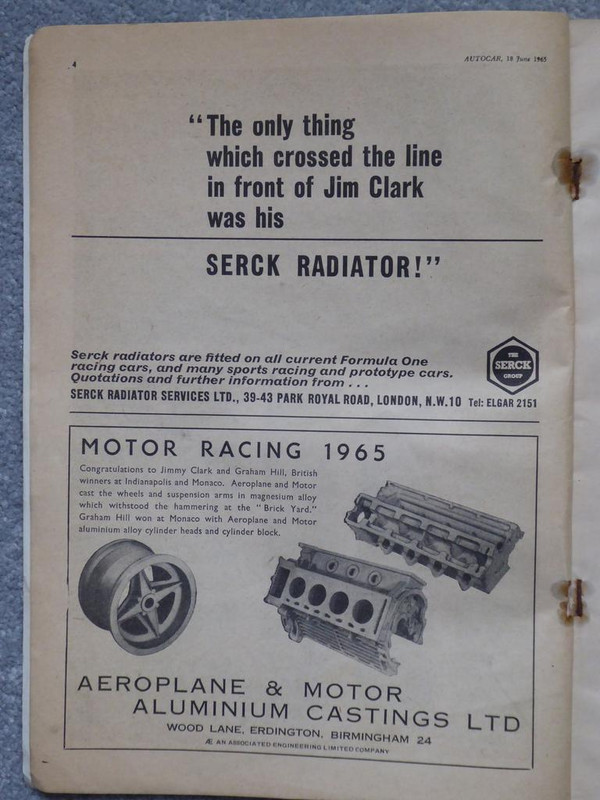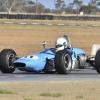One for the BRM experts. Were BRM engines actually manufactured by them on site at Bourne, or were the individual components, heads, blocks, cranks, cams and pistons etc. made by outside speciallists to BRMs specifications?
BRM engines
#1

Posted 21 July 2018 - 07:43
Advertisement
#2

Posted 21 July 2018 - 10:21
Doug Nye's BRM history will provide the answer, of course. Without going through the full volume, it is clear that castings for major components for the V8, such as heads and blocks were contracted out. Some of the suppliers could have been from the Rubbery Owen group, of course.
#3

Posted 21 July 2018 - 10:47
It came from Rolls-Royce. I would imagine pistons came from piston manufacturers.
#4

Posted 21 July 2018 - 14:08
Some of the suppliers could have been from the Rubbery Owen group, of course.
They're a most flexible company to work with... ![]()
#5

Posted 21 July 2018 - 14:34
Major castings for the V16 were supplied by Victor Riley, presumably from Morris Motors. Carbs came from SU who were also going to build a fuel injection system. Valves came from various specialists with valve springs from Terry. Crankshafts from ?
In those early days of BRM, everything was intended to be British, of course.
#6

Posted 22 July 2018 - 19:12
In common with every other racing engine manufacturer of whom I am aware, BRM manufactured some parts for their engines in-house, while having others supplied by trusted sub-contractors. Through much of the BRM period - 1945-1974 really - major castings were provided by specialists - such as Aeroplane & Motor Ltd - and then finish-machined in the BRM 'shop at Bourne. Lucas largely provided electrics and fuel injection, Armstrong dampers, AP clutches, Lockheed or Girling brake components and so on... Nothing whatsoever unusual in that. ![]()
DCN
Edited by Doug Nye, 24 July 2018 - 07:49.
#8

Posted 23 July 2018 - 11:56
I think the crankshafts were made by Laystall...
#9

Posted 23 July 2018 - 13:08
#10

Posted 24 July 2018 - 07:50
Weyburn Engineering of Elstead produced the camshafts... Hepworth & Grandage the British pistons... Terry the valve springs...
And so on.
DCN
#11

Posted 24 July 2018 - 10:30
Considering the period BRM did very well to put those engines and cars together. Designing an engine then having to get contracters together too build it was no mean feat. And without the meg budgets that happen these days.
#12

Posted 25 July 2018 - 20:27
#13

Posted 25 July 2018 - 21:20
DCN may have the numbers, but I'd have thought that in the 1970-72 period they must have had about ten or a dozen available at any one time, given how many cars they were running. Plus there were some older ones kicking about - it was of course originally meant to be a customer sports car engine and several had also been sold to other F1 teams: McLaren, Cooper and Parnell.
#14

Posted 26 July 2018 - 03:08
Two at the track (one in the car, one spare) and one back at base being rebuilt.
And more, actually... a couple of engines doing dyno work looking for more power.
.
Edited by Ray Bell, 26 July 2018 - 03:09.
#15

Posted 26 July 2018 - 07:01
Which is about ten to a dozen. ![]()
#16

Posted 26 July 2018 - 13:36
15 to 17. Though I guess that was '73, but still pertinent I'd think.
#17

Posted 26 July 2018 - 14:19
I would have reckoned on three for each car...
Two at the track (one in the car, one spare) and one back at base being rebuilt.
And more, actually... a couple of engines doing dyno work looking for more power.
.
All that extra power was in the exhaust system (well 20hp of it supposedly)!
Regards Mike
#18

Posted 26 July 2018 - 14:37
Though it is easy to see a 20hp improvement in a change in exhausts, perhaps with a variation in the torque curve.
#19

Posted 27 July 2018 - 09:34
I'm sure they also played with cam profiles, porting, inlet trumpets and all sorts of things...
Though it is easy to see a 20hp improvement in a change in exhausts, perhaps with a variation in the torque curve.
It was a little joke. According to Lauda (and some others I believe) it was part of Stanleys 'Shtick' that when meeting with a potential new driver at the Dorchester he would be called away from the table to take an urgent call from Bourne.
He would then return to the table and announce that they had 'Found another 20hp in the exhaust system!' and recommence negotiations.
Regards Mike
Edited by blackmme, 27 July 2018 - 09:35.
Advertisement
#20

Posted 29 July 2018 - 22:12
… and then there were the BRM Lotus twin-cam engines. Apart from the baker's dozen Elan/Europa/+2 road cars put together by Mike Spence, using re-worked Bourne-supplied motors; Spence (after his death) churned out a number of road engines as upgrades for "cooking" Lotus road cars... and more than a few F3 BRM twin-cams.

Edited by elansprint72, 29 July 2018 - 22:12.
#21

Posted 30 July 2018 - 09:13
#22

Posted 30 July 2018 - 10:55
During the 1.5 litre F1 era, BRM were a supplier of complete customer cars and customer engines. The Doug Nye/Tony Rudd book on the period reports that BRM's resources were stretched but customers were essential for the continuing existence of BRM. Works BRM V8s evolved to use fuel injection but customers relied on carburettors (was FI an option in later years or for the sports car variants?)
How many V8 F1 engines existed at any time? Starters with BRM engines at the British GP give an indication:
* 1961 -- zero (BRM entered Climax engined cars)
* 1962 -- three cars
* 1963 -- ten cars
* 1964 -- twelve cars
* 1965 -- eight cars
Other cars were entered with BRM engines (1962 onwards) but did not start.
The Doug Nye/Tony Rudd book has a good go at determining how many V8s were built for F1, Tasman, hill climbers and sports car racing. Inevitably, owing to repurposing of blocks and resurrections of blow-ups, it gets a bit confusing.
BRM's change of operation to a supplier of customer engines and other bits and bobs was a progressive one -- Ford Zephyr tuning kits, a customer car for Stirling Moss, Sir Alfred Owen's instruction that BRM started to pay its way. I don't recall reading how BRM increased staff or improved facilities to support change.
Taking the 1964 start figures as an indicator, BRM must have had 20 F1 engines at different stages of preparation. The V8 was a simpler engine than the 3 litre V12 (don't even think H16), so when BRM moved on they couldn't build as many as previously. Unless they significantly extended manufacturing capacity.
#23

Posted 30 July 2018 - 13:18
During the 1.5 litre F1 era, BRM were a supplier of complete customer cars and customer engines. The Doug Nye/Tony Rudd book on the period reports that BRM's resources were stretched but customers were essential for the continuing existence of BRM. Works BRM V8s evolved to use fuel injection but customers relied on carburettors (was FI an option in later years or for the sports car variants?)
Most private owners had fuel injection from 1963.
#24

Posted 30 July 2018 - 19:25
Edited by chr1s, 30 July 2018 - 19:48.
#25

Posted 31 July 2018 - 06:49
As an aside, I recently saw an old clip on YouTube of Clark and Hill on some sports review TV programme, where Hill remarks that next year Lotus would be using BRM engines and, to show there were no hard feelings between them, he would personally be assembling Jimmy's engine. ![]()
#26

Posted 31 July 2018 - 09:49
From Doug Nye’s History of the Grand Prix Car again:Thank you again everyone for your answers, fasinating stuff, I must confess my BRM knowledge is woefully lacking! I didn't realise they produced customer engines. The whole operation sounds a lot more comprehensive than I first thought when I started the topic. I had, of course, forgotten that the company had the might of Rubery Owen behind them. Anyone have any idea when the last engines were produced? We're they still making them in the Stanley BRM period? Were the engines John Jordan used the same ones from the Yardley / Marlboro era?
Peter Windsor-Smith produced a new P192 V12 for 1974: new heads with narrower angle valves and altered porting, lighter pistons, shorter bore and longer stroke. Doug says that ex-BRM staff seem to doubt whether the short-stroke crankshaft was ever actually produced. Quoted power for the P192 showed little improvement over the old P142.
In 1977: “a final further Aubrey Woods-revised P202 engine was developed for the Stanley-BRM delivering a claimed 480bhp at 11,200 rpm but.. it failed dismally”
#27

Posted 31 July 2018 - 12:21
As an aside, I recently saw an old clip on YouTube of Clark and Hill on some sports review TV programme, where Hill remarks that next year Lotus would be using BRM engines and, to show there were no hard feelings between them, he would personally be assembling Jimmy's engine.
This was the BBC SPOTY programme in 1965. Lotus would be using the BRM H-16 in 1966, and Graham Hill joined Clark at Lotus for 1967 of course.
And don't forget BRM's 1-litre F2 engine in 1965.
#28

Posted 31 July 2018 - 12:49
As an aside. BRM 1.5lt V8s sometimes varied in power outputs. So they gave a poor V8 to Shell for them to test and analyse to see where the problems lay. Long time ago and can't remember the results, but I seem to remember that there were variations in the inlet tracts. maybe where the knife edge valve seats came from.
Edited by JtP2, 31 July 2018 - 12:50.
#29

Posted 31 July 2018 - 17:25
This was the BBC SPOTY programme in 1965. Lotus would be using the BRM H-16 in 1966, and Graham Hill joined Clark at Lotus for 1967 of course.
And don't forget BRM's 1-litre F2 engine in 1965.
I'm sure I'd seen the clip before, where Graham also urges Jimmy to consider going back to farming, although it wasn't in the clip I just saw.
#30

Posted 16 December 2018 - 23:09
Another "what if". What If BRM c1970-73 concentrated on 2 cars and 4 engines ONLY per race. Instead of spending expensive time building quantity, the money could have been spent building quality, and focusing on development. I recently read an account of the restoration of a P160E chassis, formerly owned by the Wheatcroft collection, who purchased from the BRM auction. The car was striped down to bits and pieces then repaired as needed, and re-assembled. The engine was disassembled, repaired and carefully rebuilt. According to the blogger, the reassembled engine registered 513 HP vs 440-450 in period ! The blogger states this engine included very rare "big valve" heads, but most of the improvement came from smoothing out the inlet and exhaust ports, slightly higher compression, making sure all parts measured and weighed to spec, an on- mostly detail work that could have been done in period if the emphasis wasn't to get 10 engines sorted before the next race.... I realize this claim is based upon a c2018 rebuild- with newer technology for seals, gaskets, oil, gasoline, plugs etc, but 60 HP ? Heck, another 25 HP would have made difference in period.
http://brmp160e10.bl...st-results.html
#31

Posted 17 December 2018 - 14:49
I see from the interesting link you provided that the engine was tested in the car on a chassis dyno. This muddies the water somewhat, as an allowance has to be made for transmission losses. If, for example, they measured 420 bhp at the wheels and allowed for an 8% transmission loss they would have concluded they had 456bhp at the flywheel. If, however, they assumed 15% losses they would conclude they had 494bhp at the engine.
Nevertheless, one would think the fettling work they describe would yield a useful performance improvement (astonishing that the ports were rough - plausible on a customer engine perhaps, but one prepared for their own use? - time pressure I suppose).
Steve
#32

Posted 17 December 2018 - 14:54
Hmmmm - I wonder just how well calibrated (for accuracy) that recent-use dyno might have been... Not that I am at all sceptical, of course. ![]()
DCN
#33

Posted 17 December 2018 - 15:09
Hmmmm - I wonder just how well calibrated (for accuracy) that recent-use dyno might have been... Not that I am at all sceptical, of course.
DCN
Hence the expression- "Well, Stanley, that another fine mess you've got me into".
I'll get me coat.... ![]()
#34

Posted 17 December 2018 - 17:22
I have seen on a historic F3 site that someone, whether it was BRM in-period, or after the fact manufactured BRM cast rocker covers for the Kent motor. I was looking to see if this were the case, as I'd love to sport one in my historic Formula Ford...
#35

Posted 17 December 2018 - 19:15
Certainly for twin cams in later years.
#36

Posted 17 December 2018 - 21:08
Hence the expression- "Well, Stanley, that another fine mess you've got me into".
Another nice mess, shurely?
#37

Posted 18 December 2018 - 09:06
I have seen on a historic F3 site that someone, whether it was BRM in-period, or after the fact manufactured BRM cast rocker covers for the Kent motor. I was looking to see if this were the case, as I'd love to sport one in my historic Formula Ford...
New ones are available (e.g. on historicracing.org.uk) but it doesn't say whether it is based on an original design or not.
#38

Posted 18 December 2018 - 16:00
Another nice mess, shurely?
"Don't call me Shirley!"
#39

Posted 18 December 2018 - 18:51
In Howden Ganley's Road to Monaco there's a humorous reference to just such an exchange with Stanley--p.251. Negotiations at the Dorchester interrupted by an urgent call saying "...they've found another 20 horsepower"....
It was a little joke. According to Lauda (and some others I believe) it was part of Stanleys 'Shtick' that when meeting with a potential new driver at the Dorchester he would be called away from the table to take an urgent call from Bourne.
He would then return to the table and announce that they had 'Found another 20hp in the exhaust system!' and recommence negotiations.
Regards Mike
Advertisement
#40

Posted 18 December 2018 - 21:52
Which rather contrasts with Cosworth's approach to BHP quotes when their DFV was at the height of its fame. When pressed, they say, Keith Duckworth merely used to say 'Enough', and not be drawn any further ....
#41

Posted 19 December 2018 - 07:09
#42

Posted 19 December 2018 - 17:40
Another nice mess, shurely?
…..also "gotten" rather than got.... I must try harder. ![]()
#43

Posted 19 December 2018 - 20:12
Echoes of Rolls-Royce, although in their case the output was 'sufficient'.
I did read somewhere that they freely quoted the output of the marine versions of the engines.
I think the Rolls Royce engine in the Marina sports racer was a marine one - hence the name.
























